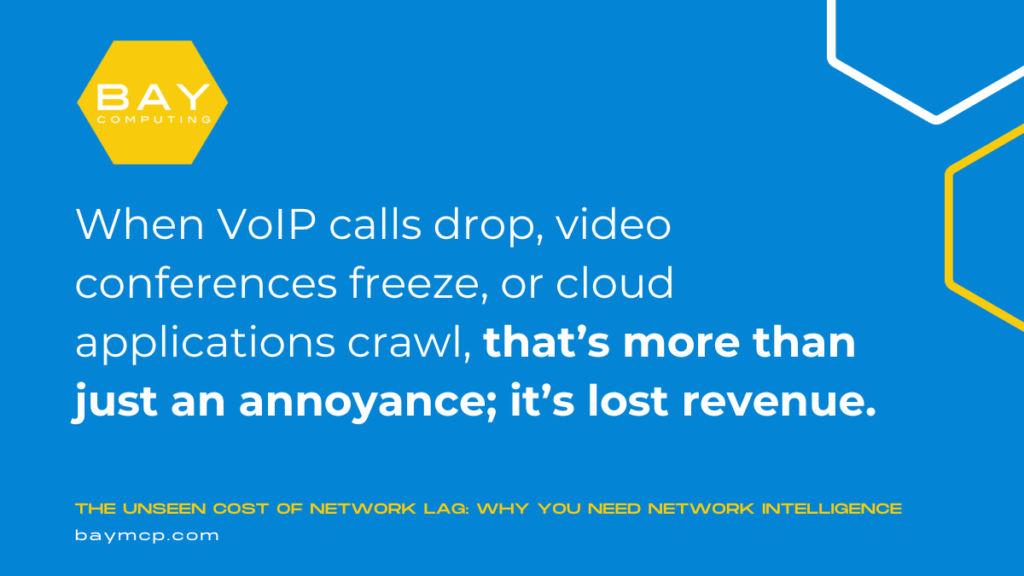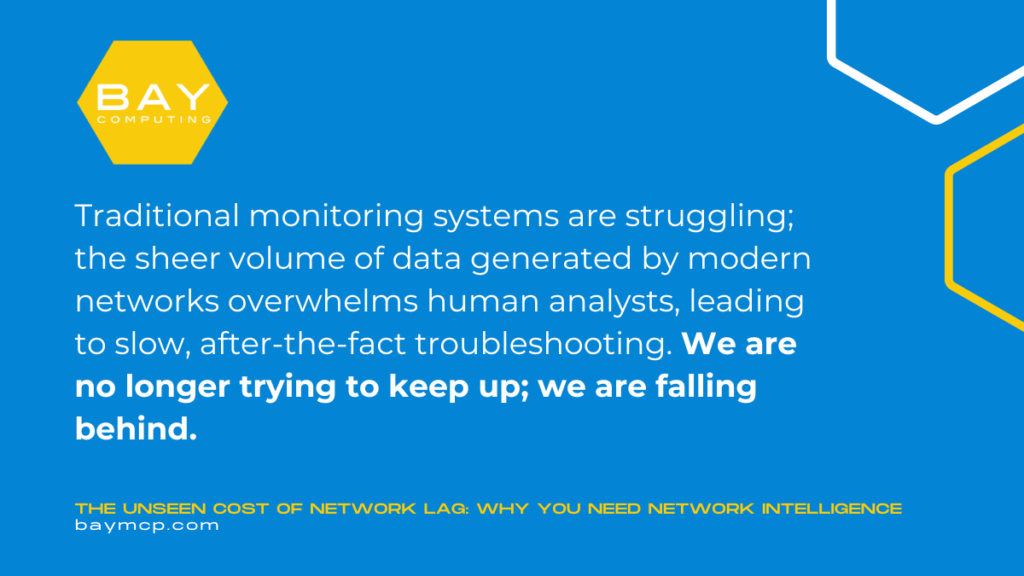The Unseen Cost of Network Lag: Why You Need Network Intelligence
The biggest daily threat to businesses relying on digital frameworks often isn’t a headline-grabbing ransomware attack, it’s the insidious, quiet erosion of productivity caused by a slow, complex, and unpredictable network. When VoIP calls drop, video conferences freeze, or cloud applications crawl, that’s more than just an annoyance; it’s lost revenue.

In an era where businesses operate across cloud, hybrid, and edge computing environments, relying on outdated network performance monitoring (NPM) techniques is no longer sustainable. Complexity is scaling exponentially, and manual methods are simply overwhelmed.
You need a strategic pivot. The goal is to stop reacting to failures and start anticipating performance issues. At Bay Computing, we recognize that true network efficiency requires embracing the architecture of the future. We’ve defined the five essential, modern strategies that transform your infrastructure from a vulnerable cost center into a powerful, predictive business asset designed for seamless operation.
1. Prioritize Performance with Dynamic QoS and SD-WAN
Imagine every data packet entering your network standing in the same queue. This is the reality of many traditional networks, where a high-priority video meeting is treated identically to a file backup. True efficiency demands prioritization. Quality of Service (QoS) mechanisms allow organizations to dynamically control traffic flow by assigning dedicated bandwidth and preferential routing to critical, resource-intensive applications like videoconferencing, Voice over IP (VoIP), or enterprise resource planning (ERP) systems.
Modern Software-Defined Wide Area Networking (SD-WAN) elevates this process. SD-WAN utilizes application-aware routing and active QoS policies to continuously monitor the health of network connections. If a segment becomes congested, the SD-WAN automatically redirects critical traffic to meet specified quality standards, proactively controlling jitter and lowering latency. This ensures that your critical business operations always benefit from optimal network performance while maximizing the efficiency of your existing resources.
2. Segment Your Network with Zero Trust Architecture (ZTNA)
Many businesses still operate with a soft internal shell: once an attacker breaches the perimeter, they can move freely (lateral movement). This “flat” network design not only facilitates breaches but also contributes significantly to congestion. Network segmentation, the practice of dividing your network into isolated subnetworks, addresses both problems simultaneously.

By isolating data and user groups, segmentation reduces the attack surface and ensures that any breach is contained to a small area, dramatically reducing the blast radius. More critically for performance, it restricts unnecessary data flow, reducing the number of connected devices sharing bandwidth, which directly alleviates network congestion.
This is reinforced by the Zero Trust Architecture (ZTNA) philosophy: “Never Trust, Always Verify”. ZTNA enforces the Principle of Least Privilege, granting users and devices only the minimum access needed for their specific tasks. By constraining access, ZTNA actively limits extraneous network traffic, making authorized traffic faster and the network inherently more secure. (Learn how we implement advanced segmentation strategies with our Cybersecurity Services.)
3. Shift from Monitoring to AI-Driven Network Intelligence
The most significant evolution in network management is the transition from reactive Network Performance Monitoring (NPM) to proactive Network Intelligence. Traditional monitoring systems are struggling; the sheer volume of data generated by modern networks overwhelms human analysts, leading to slow, after-the-fact troubleshooting. We are no longer trying to keep up; we are falling behind.

The future is predictive. Emerging capabilities in Artificial Intelligence (AI) and Machine Learning (ML) are enabling automated discovery, predictive insights, and automated next-best-actions. By aggregating disparate data sources: flow, API, SNMP, and packet data, AI models can analyze vast amounts of information, identify complex anomalies, and flag potential outages before they occur.
This shift is recognized by 71% of industry experts as having the biggest impact on NPM in the next three years, ensuring high availability and minimizing the costly impact of unexpected downtime. This intelligent approach enhances the abilities of your IT team while keeping operational costs in check. (For more on industry trends, explore the 2024 Network Performance Monitoring Trends Report.)
4. Master Endpoint Security and Wireless Integrity
Your network is only as fast and secure as the endpoints connected to it—laptops, smartphones, and tablets. These devices are often the weakest link and a primary gateway for infiltration, which can introduce malware that consumes network resources and degrades performance. Comprehensive endpoint security and stringent wireless management are non-negotiable for efficiency.
Actionable steps include ensuring all corporate Wi-Fi utilizes the most robust encryption protocol, WPA3, and establishing distinct, isolated guest networks. Furthermore, implementing Network Access Control (NAC) ensures that only authorized, compliant devices can connect. Managing these endpoints under the Zero Trust framework, with continuous verification and regular device updates, prevents misconfigurations and malicious activity from compromising network integrity and slowing down legitimate traffic.
5. Ensure 360-Degree Observability through Deep Packet Analysis
When performance issues strike, superficial metrics are not enough. In complex hybrid environments, network administrators require absolute clarity to diagnose problems rapidly.
While flow analysis provides general traffic summaries, deep packet-level forensics offers the granular detail necessary to pinpoint the exact root cause of latency, jitter, or application failure.

Proactive monitoring and performance management should combine flow analysis with packet analysis for full visibility. This comprehensive trouble-resolution workflow allows IT teams to rapidly drill down from alerts to root cause, drastically reducing the Mean Time To Repair (MTTR). By proactively monitoring traffic and device status, you can identify bottlenecks and troubleshoot issues before they become full-blown operational crises, ensuring optimal performance. (Achieve predictable performance with our Managed Network Services.)
Taking Action
Network complexity is not slowing down. Trying to manage dynamic, modern networks with legacy tools is a losing game, resulting in high costs, crippling vulnerability, and chronic frustration. The cost of standing still is measured in lost customer trust and millions in potential breach remediation.
Bay Computing helps businesses like yours achieve predictable, reliable network performance and uptime by proactively monitoring and maintaining your network to prevent downtime and improve connectivity. Stop reacting to network failures.
Schedule a Network Intelligence Audit with Bay Computing today and let us transform your network from a reactive liability into your greatest asset for growth across Massachusetts and the entire US. (For strategic planning guidance, refer to the NIST Cybersecurity Framework (CSF 2.0). Small businesses can also utilize the foundational security advice from the FCC Small Biz Cyber Planner 2.0.)




